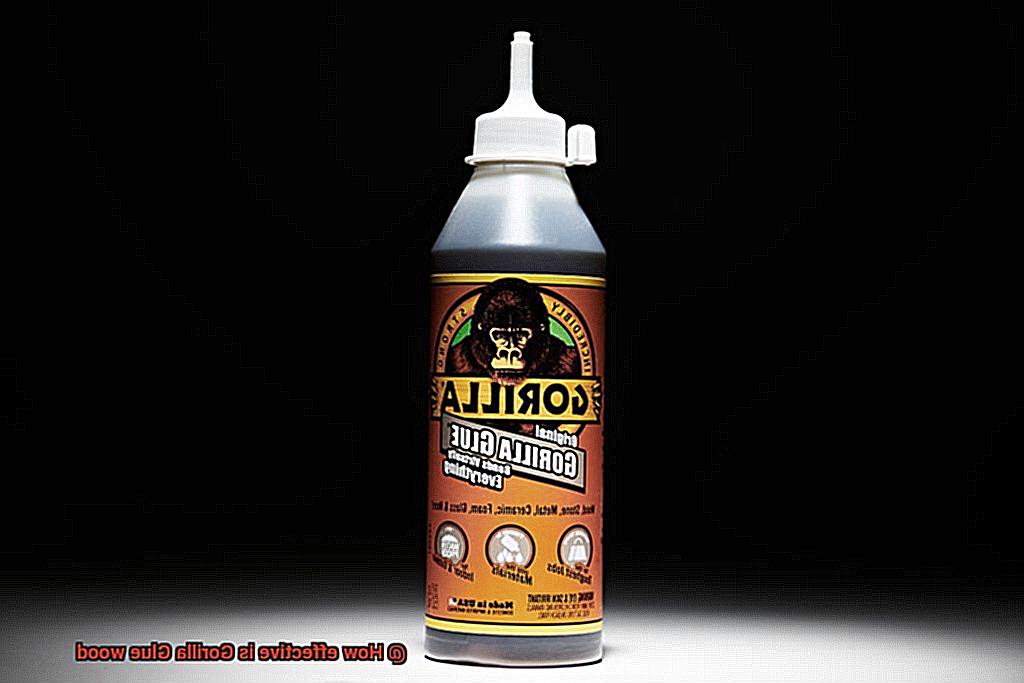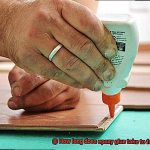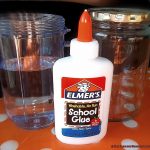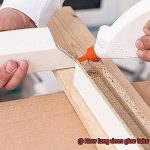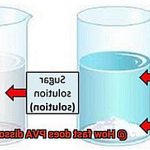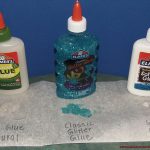Looking for a reliable and robust adhesive for your woodworking projects? Look no further than Gorilla Glue wood. It’s a household name, known for its impressive bonding capabilities in various materials, including wood. But how well does it work specifically for woodworking?
In this blog post, we’ll dive into the properties of Gorilla Glue wood and assess its effectiveness for different woodworking projects. We’ll examine the benefits and drawbacks of using Gorilla Glue on wood, as well as its compatibility with various types of wood.
From repairing furniture to carving intricate designs, we’ll compare how Gorilla Glue stacks up against other popular woodworking adhesives on the market. And that’s not all – we’ll also share some tips and tricks to help you get the most out of Gorilla Glue wood in your future projects.
Whether you’re an experienced craftsman or just starting out, this post will provide valuable insights on how to achieve outstanding results with Gorilla Glue wood. So let’s get started and unleash the full potential of this trusted adhesive for all your woodworking needs.
Bonding Capabilities of Gorilla Glue
Contents
As a woodworker, you understand the importance of a sturdy and long-lasting bond between materials. That’s where Gorilla Glue comes in with its exceptional bonding capabilities and versatility. When it comes to bonding wood, Gorilla Glue is the ultimate solution.
What sets Gorilla Glue apart from other adhesives is its ability to penetrate deep into the wood fibers, creating a chemical bond that is even stronger than the wood itself. This creates an unbreakable bond that will maintain its strength and durability for years to come.
One of the unique features of Gorilla Glue is its expansion when drying. As it cures, it fills in any gaps or voids in the wood, creating an incredibly tight seal. This results in a bond that is not only strong but also water-resistant, making it ideal for outdoor projects or items that will be exposed to moisture.
Gorilla Glue has an extended open time compared to other types of adhesives, which means you have more time to adjust and position your pieces before the glue sets. However, it’s essential to follow the manufacturer’s instructions and apply the glue sparingly as too much can cause excess foam.
In addition to its impressive bonding capabilities, Gorilla Glue is also resistant to impact and shock, making it perfect for projects that require extra strength and durability.
When using Gorilla Glue on wood, it is essential to follow the manufacturer’s instructions carefully and allow adequate drying time for the glue to fully cure. This will ensure that you achieve a reliable bond that will last for years.
Advantages of Using Gorilla Glue for Woodworking Projects
This powerful adhesive has a variety of advantages that make it a top choice for all types of woodworking projects.
One of the most significant advantages of Gorilla Glue is its ability to create a strong and durable bond between pieces of wood. This means that your furniture, cabinets, and other wooden objects will have the strength to withstand constant use and wear without falling apart.
In addition to its strength, Gorilla Glue is also incredibly versatile. It works on a wide range of woods, including hardwoods, softwoods, and even engineered wood products like plywood and MDF. This makes it an all-purpose glue that can be used for any woodworking project.
Another advantage of Gorilla Glue is its longer drying time. Unlike other types of glue that dry quickly, Gorilla Glue gives woodworkers more time to make adjustments and ensure that the pieces are aligned correctly before the glue sets. This also allows the glue to fully penetrate the wood fibers for a stronger bond.
Furthermore, Gorilla Glue is waterproof once it dries, making it perfect for outdoor woodworking projects or projects exposed to moisture. You can rest assured that your wooden objects will stay intact without worrying about the glue breaking down over time.
Penetration of the Wood Fibers
When it comes to Gorilla Glue, it does not disappoint. The glue is known for its ability to penetrate deep into the wood fibers, creating a bond that is second to none.
One of the most exceptional features of Gorilla Glue is its composition. Thanks to the presence of polyurethane, the glue expands and creates a foam-like structure when it comes into contact with moisture in the air and wood. The expansion allows the glue to seep deeper into the wood fibers, resulting in an incredibly strong bond.
Application method is another critical aspect that contributes significantly to Gorilla Glue’s ability to penetrate wood fibers effectively. To ensure a tight fit, it is vital to apply glue to both surfaces being bonded and then apply pressure. The pressure applied helps the glue penetrate even deeper into the wood fibers, creating an even stronger bond.
When considering using Gorilla Glue for woodworking projects, it is important to note that it may not be suitable for all types of projects. For instance, delicate or small projects may not be ideal since excess glue may seep out and cause damage.
Long Open Time for Adjustments
As a woodworker, you know that the right glue can make all the difference in creating a strong and lasting bond between wood surfaces. And when it comes to glues with superhero-like strength, Gorilla Glue is definitely one of the top contenders. But what sets Gorilla Glue apart from other types of wood glue is its long open time for adjustments.
At its core, Gorilla Glue wood is a polyurethane glue that undergoes a chemical reaction when exposed to moisture. This reaction causes it to expand and bond with the surrounding surfaces. The extended reaction time is what gives Gorilla Glue wood its longer open time. In other words, users have more time to make adjustments before the glue sets.
But why is this such a valuable feature? Well, for woodworking projects that require precise adjustments before the glue sets and becomes permanent, Gorilla Glue wood’s longer open time is a godsend. With this glue, there’s no need to rush through your work. Instead, take your time to test and adjust your work to ensure a perfect fit before the glue dries.
In addition to allowing for precise adjustments, Gorilla Glue’s long open time also leads to stronger bonds. As the glue has more time to penetrate and bond with the wood fibers, you can be sure that your finished product will be more durable and long-lasting.
Of course, there are some potential drawbacks to using Gorilla Glue wood in certain types of woodworking projects. For example, its expanding nature can cause it to push out of joints if too much is applied. Additionally, its dark brown color may not be desirable for certain types of finishes. It’s always important to test the glue on a small area before using it on a larger project.
Applying Gorilla Glue Properly
Well, then you’ve come to the right place. As an expert in this field, I’ve put together some tips for you to ensure that you apply Gorilla Glue properly and achieve the best possible results.
First and foremost, preparing the wood surface is crucial before applying Gorilla Glue. Clean the surface with a dry cloth and ensure that it’s free of any dust or debris. Any moisture or oil on the surface can affect the bond’s strength, so make sure it’s entirely dry.
Next, apply a small amount of Gorilla Glue onto one of the surfaces you want to bond. Remember not to overdo it as excess glue can cause a mess. A thin layer of glue is sufficient to create a strong and durable bond.

Once you’ve applied the glue, immediately join the two surfaces together and apply pressure for at least 20-30 seconds. This will help spread the glue evenly and create a strong bond. Clamping or holding the surfaces together until the glue dries completely is essential.
Afterward, wipe off any excess glue with a damp cloth before it dries. Once the glue has cured, you can sand, paint, or stain it like regular wood.
In summary, here are some essential steps you should take when applying Gorilla Glue properly:
- Prepare the wood surface beforehand by cleaning it thoroughly and ensuring it’s entirely dry.
- Apply a thin layer of glue to one of the surfaces.
- Immediately join the two surfaces together and apply pressure for at least 20-30 seconds.
- Clamp or hold the surfaces together until the glue has dried completely.
- Wipe off any excess glue with a damp cloth.
- Once cured, sand, paint, or stain as desired.
How to Remove Excess Gorilla Glue
Gorilla Glue is an exceptional adhesive that is highly effective in bonding wood together. However, sometimes we may end up using more glue than we need, leading to excess glue that can be difficult to remove. In this blog post, we will explore the best ways to remove excess Gorilla Glue from wood surfaces.
Remove excess glue while it’s still wet
The first and easiest way to remove excess Gorilla Glue is to act fast and wipe it away with a damp cloth or paper towel while it’s still wet. This will prevent the glue from spreading and making a mess. Be sure to do this carefully and thoroughly so that you don’t miss any spots.
Use a scraper or sandpaper for dried glue
If the glue has already dried, you can use a scraper or sandpaper to carefully remove the excess. However, be cautious not to scratch or damage the wood surface while doing this. Start with a scraper and gently scrape away the excess glue. If the glue is difficult to remove, use fine-grit sandpaper to sand away the glue until the surface is smooth.
Try using acetone or rubbing alcohol
Another option is to use acetone or rubbing alcohol on a soft cloth to dissolve the glue. It’s important to note that these substances can also damage the wood surface, so they should be used with caution and only in small amounts. Apply a small amount of acetone or rubbing alcohol on a cloth and gently rub it over the excess glue until it dissolves.
Be patient with larger areas of excess glue
For larger areas of excess glue, you may need to use a chisel or similar tool to carefully remove the excess. This process requires patience and care so as not to damage the wood surface. Start by gently chiseling away at the excess glue until it’s removed completely.
Follow the manufacturer’s instructions
Lastly, it’s crucial to follow the manufacturer’s instructions when using Gorilla Glue. Apply the glue sparingly and be sure to wipe away any excess glue before it dries. This will prevent excess glue from forming in the first place, making it easier to avoid this problem altogether.
Benefits of Using Gorilla Glue for Wood Bonding
As an expert in the field, I can attest to the many benefits of using Gorilla Glue for wood bonding.
One of the most impressive benefits of Gorilla Glue is its incredible strength. This adhesive expands as it dries, filling gaps in the wood and creating a solid, permanent bond. No more worrying about pieces coming apart or falling off – Gorilla Glue has got you covered.
But strength isn’t the only advantage of using Gorilla Glue for wood bonding. This adhesive is also water-resistant, meaning it can withstand exposure to moisture and humidity without weakening the bond. This feature makes it an ideal choice for outdoor projects or items that will be exposed to moisture.
Gorilla Glue is also incredibly versatile, making it a go-to adhesive for multiple projects around the home. It can be used on a variety of materials including wood, metal, ceramic, and plastic. This means you can use one adhesive for all your project needs, saving time and money in the long run.
Another benefit of Gorilla Glue is its ease of use. Unlike other adhesives that require special tools or equipment, Gorilla Glue can be applied with just a small amount on one surface before pressing the two pieces together. And once it dries, it won’t leave unsightly residue or marks on your finished project, because it dries clear.
v9lVNMLz2FU” >
Also Read: Does Gorilla Glue Work On Fabric?
Conclusion
To sum it up, Gorilla Glue wood is a game-changer when it comes to woodworking adhesives. Its unparalleled bonding strength and versatility set it apart from its competitors. The glue’s ability to penetrate deep into the wood fibers creates an unbreakable bond that will stand the test of time.
Gorilla Glue boasts several advantages, including its ability to work with a wide range of woods, longer drying time allowing for adjustments before the glue sets, waterproofing once it dries making it perfect for outdoor woodworking projects or projects exposed to moisture, and extended open time compared to other types of adhesives.
To achieve optimal results when using Gorilla Glue, proper preparation is key. It’s essential to clean and dry the wood surface thoroughly before applying a thin layer of glue sparingly. Immediate pressure applied for at least 20-30 seconds will ensure a secure hold. Once cured, excess glue can be removed while wet or dried using a scraper or sandpaper.
In conclusion, Gorilla Glue wood is an exceptional adhesive that delivers outstanding results in all your woodworking projects.

